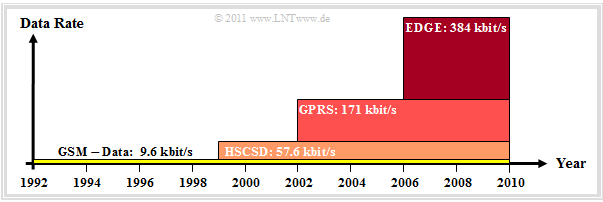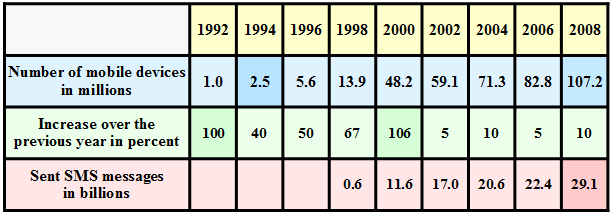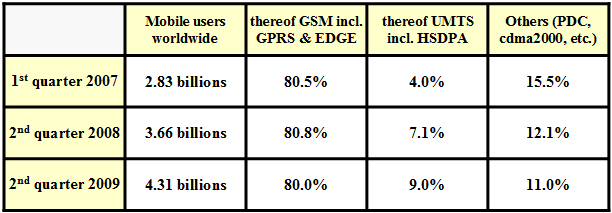Contents
SYNOPSIS OF THE THIRD MAIN CHAPTER
In the following, the most important representatives of the mobile radio systems established in 2011 are briefly introduced:
- GSM - Global System for Mobile Communications: Second generation of mobile communications (2G);
detailed description in the third chapter of the book Examples of communication systems.
- UMTS - Universal Mobile Telecommunications System: Third Mobile Generation (3G);
detailed description in the fourth chapter of the book Examples of communication systems.
In detail are discussed:
- Characteristics and examples of the different mobile radio generations (1G, 2G, 3G),
- some statistics on the increase in the number of mobile users,
- basic similarities and differences between GSM and UMTS,
- important system components: voice and channel coding, interleaving, encryption,
- the multiple access methods FDMA/TDMA (GSM) and CDMA (UMTS),
- the modulation procedures GMSK (GSM) and OFDM (UMTS),
- The further developments HSCSD, GPRS, EDGE (GSM) as well as HSDPA, HSUPA (UMTS).
Subsequently, the fourth chapter the newer mobile radio system LTE (Universal Mobile Telecommunications System) is discussed.
Precursor of today's mobile radio networks
Today (2017) every child knows what mobile radio is, and only a few young people can imagine that life is possible without a smartphone, Facebook and the countless mobile phone–features. Twenty years ago, things were completely different: Only a few knew about the existence of such mobile communication systems and even fewer had ever held a mobile phone in their hands until then.
An important prerequisite for the realization of mobile communication systems was the theory of electromagnetic waves, which James Clerk Maxwell developed in 1864 and was decisively further developed by Heinrich Hertz . Another great pioneer of radio technology was Guglielmo Marconi, who in 1896 publicly demonstrated wireless telegraphy for the first time and in 1901 succeeded in making the first transatlantic–radio transmission. In 1909 he received the Nobel Prize for his inventions.
Since Marconi–technology was also used intensively in transatlantic–shipping and its use was even prescribed after the sinking of the Titanic (1912), the emergence of mobile communication systems can be dated to around the beginning of the 20th century.
The first mobile radio network in Germany was the A–Netz, which was put into operation in 1958 and shut down in 1977. It operated in the frequency range from 156 MHz to 174 MHz with analogue frequency modulation (FM) and was used nationwide by up to 11000 subscribers (but certainly not simultaneously). The transmission technology filled the trunk of large limousines.
The B–network operated from 1972 to 1994 was also based on analogue FM around 150 MHz. At its heyday around 1985, this was used by 27000 subscribers and provided 850 radio channels, already taking into account the reuse of the same frequencies in sufficiently distant radio cells. The volume of the transmitting– and receiving equipment was significantly smaller than that of the A–network due to the progress made in the meantime in the field of microelectronics.
The last predecessor model of today's systems is the analogue C–Netz in the frequency range around 450 MHz, which was operated in Germany between 1986 and 2000 by the Deutsche Bundespost. In 1993 it had its maximum number of subscribers of 850000, offered a coverage of 98% and provided some features which became standard for the following generations of mobile phones, for instance "Handover" and "Roaming".
The C–network is considered to be part of the first generation of mobile communications as well as some other cellular systems that emerged almost simultaneously in other countries:
- AMPS (Advanced Mobile Phone Service), Bell Labs, USA, 1979,
- ACS (Advanced Cellular System), Comvik, Sweden, 1981,
- NMT (Nordic Mobile Telephone), Sweden–Norway–Denmark, 1981 and 1986,
- TACS (Total Access Communication Standard), Great Britain, 1985,
- RTMS (Radio Telephones Mobile System), Italy, 1985,
- RC 2000 (Radio Com 2000), France, 1986.
Second generation mobile radio systems
All the first generation mobile systems mentioned above (1G) were national solutions with the following consequence:
- It was not possible to communicate between the individual systems.
- The end devices (one should not talk yet of cellphones) could be used only in the respective network, whereby the market was very limited and the economic success failed to materialize.
At the beginning of the 1980s there were already initial efforts to unify the system. The second generation (2G) of mobile radio systems was created, characterized by
- a continuous digital voice transmission,
- the provision of data services.
In the second generation mobile radio systems, voice transmission was the central task and data transmission was rather secondary, whereas a characteristic of the third generation, for example of UMTS , was the so-called mobile Internet.
The most important 2G–mobile communications standard was GSM – Global System for Mobile communications. This system presented in the chapter System Architecture and Base Units of GSM was not only widely used in Europe, but many regions worldwide have also adopted this standard. GSM was the fastest growing communication technology of all times until then.
The different GSM–systems were
- GSM 900: frequencies around 900 MHz (D–networks; in Germany TD1 and Vodafone D2),
- GSM/DCS 1800: frequency range around 1.8 GHz (E–networks; in Germany all operators at that time),
- GSM/PCS 1900: Frequency range around 1.9 GHz (mainly used in the USA)
In addition, second-generation mobile communications systems are also included:
- the PDC–Netz (Personal Digital Cellular),
- the "Cordless–Standard" DECT (Digital Enhanced Cordless Telecommunications),
- the satellite system standards LEO (Low Earth Orbit) and MEO (Medium Earth Orbit),
- the terrestrial aeronautical radio network ⇒ TFTS (Terrestrial Flight Telephones System),
- Test networks in the USA such as D–AMPS and Qualcomm–CDMA.
After all, 2G–mobile radio systems also include "wireless local loops" with very limited mobility such as
- WLL (Wireless Local Loop) and
- RLL (Radio in the Local Loop ).
The genesis of GSM
The GSM–standard was introduced around 1990 with the aim of providing a unified pan-European mobile telephone system and network. The use for data transmission was not the main focus, but was constantly improved by additional specifications regarding data rate.
Below are some data on the historical development of GSM:
- 1982 At the "Conférence Européenne des Postes et Télécommunications" (CEPT) the Groupe Spécial Mobile – abbreviated GSM – is established.
- 1987 Cooperation is formed between 17 future operators from fifteen European countries and work is begun on the GSM specification.
- 1990 Phase 1 of the GSM 900 specification (for 900 MHz) is completed. Matching for the GSM/DCS 1800 system (Digital Cellular System) around the frequency 1.8 GHz begins.
- 1992 Most European GSM network operators start commercial operation with voice services. By the end of 1992, thirteen networks in seven countries were already "on air".
- 1995 Phase 2 of standardization begins and includes fax, data and SMS–roaming and adaptations for GSM/PCS1900, which goes into operation in the USA in the same year.
- 1999 With the introduction of WAP (Wireless Application Protocol), it will be possible for the first time to transfer Internet content and other interactive service offerings to mobile devices.
- The introduction of HSCSD (High Speed Circuit–Switched Data) increases the data rate from 9.6 to 14.4 kbit/s and further to 57.6 kbit/s by bundling four TDMA–channels.
- 2000 The GPRS extension (General Packet Radio Service) simplifies wireless access to packet-switched data networks. The maximum data rate is (theoretically) 171 kbit/s.
- 2000 Phase 2+ defines EDGE (Enhanced Data Rates for GSM Evolution), which could theoretically triple the GPRS–rate. In reality, however, only 384 kbit/s are actually reached.
- 2006 T–Mobile is the first German mobile phone provider to begin providing EDGE. In the next few years, the operators Vodafone, O2 and E–Plus will follow suit in Germany.
The graph shows the development of the GSM–data transmission rate on a linear scale. The abscissa indicates the year of market launch (in Germany), not the year of standardization. There were always several years in between.
Third generation mobile radio systems
Shortly after the GSM–standardization it became apparent that the bandwidth requirements for the use of multimedia services could not be covered. The next, third generation of mobile radio systems should be based on the CDMA–Principle (Code Division Multiple Access).
Essential preparatory work was:
- 1949 First ideas for CDMA–procedure by Claude Elwood Shannon and John Robinson Pierce.
- 1970 Various CDMA–developments for military systems, for example GPS (Global Positioning System).
- 1989 –1992 basic research on the characteristics of future mobile radio systems within the framework of the EU–RACE–1 programme (Research, Analysis, Communication, Evaluation).
- 1992 –1995 EU–Program RACE–2nd focus "Development of system concepts", based on the results of RACE–1.
First considerations on the standard IMT–2000 (International Mobile Telecommunications at 2000 MHz) were made by the ITU in 1992. From this, with UMTS (Universal Mobile Telecommunications Systems) the best known mobile radio system of the third generation (3G) developed. However, a number of intermediate steps were still necessary before it could be launched in Germany (2004):
- 1996 foundation of the UMTS–Forum in Zurich – renaming of the planned European standard "W–CDMA" to "UMTS".
- 1998 Adoption of the modes "W–CDMA" and "TD–CDMA" into UMTS–standard at the ETSI–SMG–meeting in Paris.
- 1998 Foundation of the 3gpp–Forum (3rd Generation Partnership Project) by the committees ETSI–SMG, T1P1, ARIB TTC and TTA.
- 1999 Adoption of the UMTS–R99 standard (Release 1999) by ETSI. This standard is considered the basis for the first available UMTS–terminals.
- 2001 UMTS Release 4 as a further development of UMTS–R99: Quality of Service (QoS) is now supported not only on the radio interface but also in the fixed network.
- 2001 First commercial UMTS–network of the Norwegian company TELENOR.
- 2002 UMTS Release 5: The architecture based on the GSM–fixed network is replaced by a completely IP–based network. In addition, HSDPA is defined.
- 2002 First UMTS–voice– and data connection from Nortel Networks and Qualcomm. These companies are considered pioneers in the implementation of UMTS–technology.
- 2005 UMTS Release 6, offering users improved QoS and providers more effective resource management. Besides definition of HSUPA.
- 2007 UMTS Release 7. consideration of real-time applications such as VoIP (Voice over IP) and Evolved EDGE (only shortly after the market launch of 2G–EDGE).
These annual figures refer in each case to the specification. It usually took another two to four years before a further development was actually used.
Let us briefly summarize the list so far, whereby we refer mainly to the situation in Europe and especially in Germany around 2011:
$\text{Definition:}$ The third-generation mobile communications systems (3G) include
- UTRA–FDD (UMTS Terrestrial Radio Access–Frequency Division Duplex) according to the UMTS–Specifications up to and including Release 7.
- This includes HSDPA (High Speed Downlink Packet Access) according to UMTS Release 5 and HSUPA (High–Speed Uplink Packet Access) according to UMTS Release 6.
- The GSM–Further Development EDGE (in higher modes with 8– PSK–modulation) is assigned to "3G" whereas GPRS still belongs to the 2G–systems.
The development of UMTS is far from being completed with the standards mentioned above:
- In December 2008, Release 8 specified, among other things, the variant E–UTRA (evolved UTRA ), better known as Long Term Evolution (LTE).
- Already in March 2011 with the UMTS Release 10, LTE, which had not yet been introduced at all, was then further developed into LTE Advanced (LTE–A).
These mobile communications standards, which will be the latest in 2011, are discussed in detail in the fourth main chapter of this book Mobile Communications . They belong to the fourth generation of mobile communications systems (4G). Already at this time it was foreseeable that further generations would follow.
But before that, we will deal in a highly compressed form wit the following topics(details can be found in the book Examples of Communication Systems)
- the Characteristics of GSM, and
On the next page, we present some figures published on the Internet to illustrate the success of digital mobile communications in the years up to 2009, with a decline in GSM and a disproportionate increase in UMTS and LTE.
The success story of digital mobile radio
The following information is taken from the lecture notes [Hin08][1] as well as from various articles found on the Internet, for example from [Göt08][2] and [Waa10][3]. Not a single entry in any of the tables is based on own research of the LNTww–authors.
Growth rates of German mobile networks (as the sum of the four German providers)
- In the years from 1992 to 2008, the number of registered mobile end devices rose from one million to more than 100 million (first line). Since the end of 2005, the number of mobile subscriber lines has already exceeded the population of Germany.
- The highest growth rates were in 1992, directly after the introduction of GSM in 1992 (although still at a low level) and around the turn of the millennium (darker background in line 2). We remember the euphoria of that time shortly before "bursting of the Internet bubble" when the auction of the German UMTS licenses for a total of 20 years duration and 120 MHz bandwidth brought in more than 100,000,000,000 DM (≈ 50.8 billion Euro).
- But also the growth rates in the new millennium (between 5% and 10%) were remarkable when one considers that in 2008 every person living in Germany, including babies and old people, already owned 1.3 mobile phones on average.
- A very special success story was the introduction of short message services (SMS). In 2008, for example, almost 30 billion such short messages were sent in German mobile networks (darker background in line 4).
Development of mobile communications worldwide (based on the URL–page of [1])
- In 2009 there were more than 4.3 billion mobile subscribers worldwide. For comparison: The number of fixed network connections has been just under one billion since 2005 (probably also because a telephone system only counts as one connection), and since then has declined slightly but steadily.
- The annual growth rates worldwide have recently been well over 20% and thus above the figure for Germany. This can certainly be explained by the fact that in some countries in 2009 there was not yet as much saturation as in Central Europe.
- The GSM–share was stable at around 80% between 2006 and 2009. The UMTS–share (including HSDPA) increased from 4% to 9% from 2007 to 2009, mainly at the expense of the Japanese "PDC" and the American "cdma2000" systems.
Distribution of mobile local loops on the individual continents (figures from 2008 and 2009)
- The most interesting market for mobile communication systems is clearly Asia. In 2009, 44% of all participants were already registered there and the percentage has certainly risen further in the meantime.
- It should also be noted that the percentage increase in Asia's–share from 42.2% (2008) to 44% (2009) meant an increase of 350 million lines in absolute terms.
- The relative market share of Western Europe fell from 13.4% (2008) to 11.8% (2009), although the absolute figure rose from 493 million to 510 million. The same tendency could be seen in other "first–world regions" like USA and Canada.
Exercices for chapter
Exercise 3.1: Development of the Mobile Network
Bibliography
- ↑ Hindelang, T.: Mobile Communications. Vorlesungsmanuskript. Lehrstuhl für Nachrichtentechnik, Technische Universität München, 2008.
- ↑ Götze, J.: Methoden der Informationstechnik I – Digitale Mobilfunksysteme. Vorlesungsmanuskript, Fakultät für Elektrotechnik, Universität Dortmund, 2008.
- ↑ Waadt, A.: Mobilkommunikation – Mobile Communications. Vorlesungsmanuskript, Lehrstuhl für Kommunikationstechnik, Universität Duisburg–Essen, 2010.



